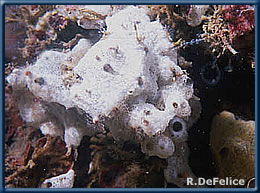

Ascidia sydneiensis

Phallusia nigra

Diademnum sp.
Didemnum candidum
 White
didemnid
White
didemnid
Phylum Chordata
Subphylum Urochordata
Class Ascidiacea
Order Enterogona
Family Didemnidae
Description
Didemnum candidum is a common white or gray
colonial ascidian that forms patches or mounds. These patches can be quite
extensive, overgrowing worm tubes, sponges, ascidians, and algae in the
fouling community.
Didemnids are very difficult to identify, even for an expert. They can
not be identified in the field. The tiny zooids must be extracted from
the tunic, which is nearly impossible, and this has led to the confusion
of didemnid taxonomy. Didemnum candidum is
one of 4 or 5 white or gray species in this Family in Hawaii, and examination
of a taxonomic key (e.g. Abbott et al. 1997) is required for positive
identification.
Habitat
In shallow water, primarily in the fouling community of protected harbors
and embayment, but also on the reefs in Kaneohe Bay. Grows on all substrates,
even living animals and algae.
Distribution
Hawaiian Islands
Throughout the main Islands, and possibly Northwestern Hawaiian Islands
Native Range
Unclear, perhaps Indo-Pacific
Present Distribution
Worldwide in warm seas
Mechanism of Introduction
Unintentional, as fouling on ships' hulls.
Impact
Fouling species. Ecological impact unstudied in Hawaii, observations suggest
some competition for space with other shallow-water species in harbors
and embayments.
Ecology
Feeding
Ascidians are suspension feeders that use a mucous net to filter plankton
from the water. Ciliary action moves water into the oral siphon and to
the pharynx which resembles a basket. As water is pumped through slits
in the pharyngeal basket, out the atrial siphon, it passes through a layer
of mucous coating the inside. When the mucous sheet is clogged with food,
special structures pass it to a short esophagus and into the stomach.
Reproduction
This species is hermaphrodite, with a simple reproductive system. Fertilization
is external, and after a time in the plankton the free-swimming tadpole
larvae will settle and metamorphose.
Remarks
The name Didemnum candidum has been applied
to a staggering number of populations of a similar-looking taxon around
the world; the species may be one of the most widely-recorded ascidians
in the world (Van Name, 1945; Eldredge, 1966). Its cosmopolitan nature
recalls Van Name's (1945) famous statement regarding this species: "I
am far from being able to overcome the fear that I am confusing more than
one species...". More than 50 years later, the species is still in
need of revision.
Records from Hawaii commence with Paul Galtsoff's collections in 1930
from Pearl and Hermes Reefs (Tokioka, 1967). Eldredge (1967) reported
it from several stations on Oahu (Kaneohe Bay, Ala Wai Yacht Harbor, Pearl
Harbor, and off Barber's Point) based upon collections from 1961 to 1963.
Long (1974) and Hurlbut (1991) further reported upon Pearl Harbor populations.
Hurlbut (1991) examined patterns of larval abundance, settlement, and
juvenile mortality in Pearl Harbor. Didemnum candidum's
greater abundance at shallow depths on floats as compared to greater depths
on pilings is due to greater larval settlement near the water surface
directly related to the surface location of larvae-producing adults, and
to the larvae being photopositive and geonegative. She also noted that
colonies of Didemnum candidum on settling plates at 0.5 meter depth are
capable of releasing larvae at 6 to 8 weeks of age.
Originally described from the Red Sea, it was reported in the 1880s and
1890s from stations as far spread as Brazil, New Zealand, the Antilles,
and off Mozambique indicating that some measure of widespread dispersal
by ships had already been achieved. It now also occurs in Australia and
New Zealand, the western Pacific Ocean, Indian Ocean, the western Atlantic
Ocean, and the Mediterranean , as well as western Europe, and the Philippines,
Gilbert, Palau, and Galapagos Islands (Tokioka, 1967). Whether it originated
in the Indo-Pacific, or elsewhere, is not clear.
References
Abbott, D.P., A.T. Newberry, and K.M. Morris. 1997. Section 6B: Ascidians
(Urochordata). Reef and Shore Fauna of Hawaii. Bishop Museum Special Publ.
64 (6B).
Eldredge, L.G. 1967. A taxonomic review of the Indo-Pacific didemnid ascidians
and descriptions of twenty-three Central Pacific species. Micronesica.
2: 161-261.
Hurlbut, C.J. 1991. The effects of larval abundance, settlement and juvenile
mortality on depth distribution of a colonial ascidian. J. Exp. Mar. Biol.
Ecol. 150: 183-202.
Long, E.R. 1974. Marine fouling studies off Oahu, Hawaii. Veliger. 17:
23-39.
Tokioka, T. 1967. Pacific Tunicata of the United States National Museum.
U.S. Natl. Mus. Bull. 251: 1-247.
Van Name, W.G. 1945. The North and South American ascidians. Bull. Amer.
Mus. Nat. Hist. 84: 1-476.
© 2002 Hawaii Biological Survey, Bishop Museum
contact